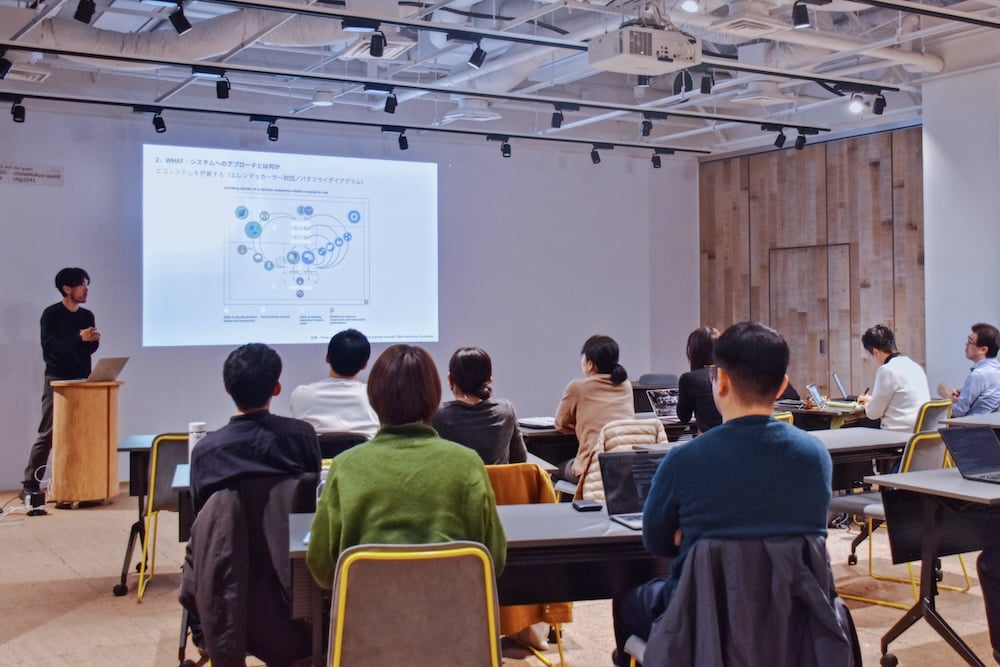CIRCULAR STARTUP TOKYO is an incubation program specifically designed to support startups in the circular economy sector. Through a variety of lectures on the circular economy, expert mentoring, and interim and final presentations, participants develop and refine business models to drive the realization of a circular economy. Ultimately, the goal is to secure funding and create social impact.
On November 22, 2024, the first session of the Circular Business Design Lecture, a key component of the program, took place. The session focused on “Circular Economy and System Design.” The speakers were Shogo Minemura, CEO of ZOUKEI-KOUSOU Inc., and Kiyokazu Nasu, CEO of Circle Design Inc.
Minemura, CEO of ZOUKEI-KOUSOU Inc. and a researcher at Musashino Art University, delivered a talk titled “Systemic Design for Responsibility.” He emphasized the importance of accurately understanding the current state of the entire system and introduced his perspectives on design as a method to respond to complex challenges, as well as techniques for design research.
Nasu, CEO of Circle Design Inc., which specializes in communications and support for circular economy businesses, explored the definition of the circular economy and shared insights on developing more structured business models.
This article provides an excerpt of the lecture.
*About the Circular Business Design Lecture
The Circular Business Design Lecture consists of five sessions. The first session provides a broad perspective on system design before progressively narrowing its focus to business design, service design, and product design in later sessions, delving deeper into the process of building circular businesses.
Have Previous Solutions Been Just Whack-a-Mole? The Importance of a Systemic Perspective
Minemura began his lecture with the theme “Systemic Design for Responsibility.”
The transition from a linear economy to a circular economy is not just an economic shift—it represents a fundamental “systemic change.” He emphasized that achieving systemic change first requires a precise understanding of the current system.
Minemura: “For those involved in circular businesses, it is crucial to first understand how the ecosystem functions—or where it fails—and then ask, ‘How can we improve the system as a whole?’ This approach is similar to how a doctor must first fully understand the body’s structure and needs in order to diagnose and treat issues effectively. While this may seem obvious, in reality, we often lack both the resources and the mindset to approach challenges in such a holistic manner.”
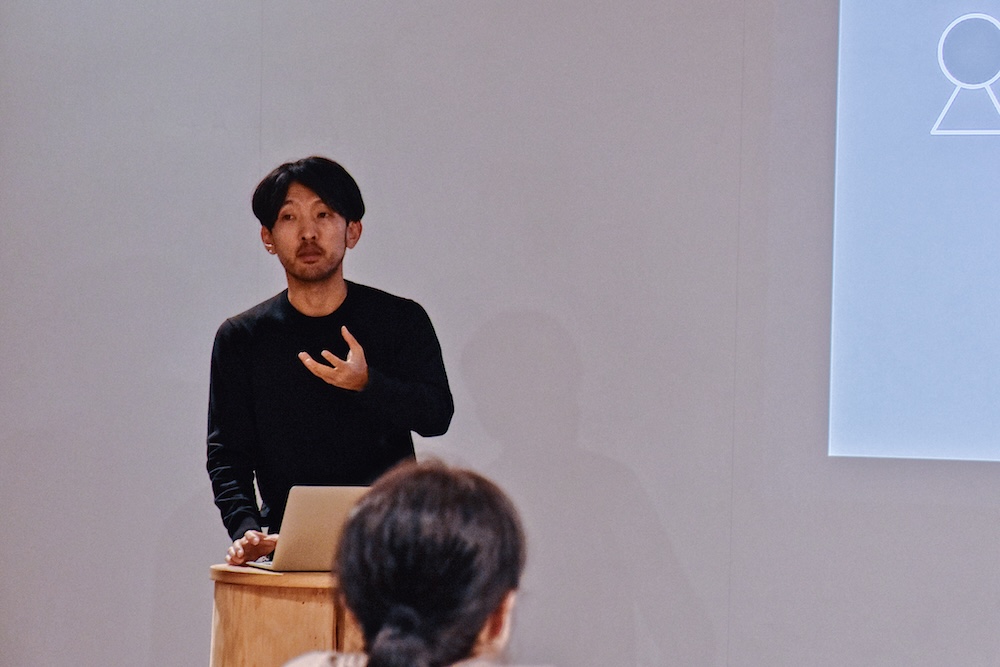
Shogo Minemura, ZOUKEI-KOUSOU Inc.
To highlight the challenges of grasping entire systems, Minemura used the example of CO2 emissions throughout the life cycle of clothing.
Minemura: “In the apparel industry, where mass disposal is a pressing concern, various initiatives aim to reduce waste. However, when we analyze the CO2 emissions across the entire life cycle of clothing in Japan, waste contributes only 1.2% of total emissions.
The majority of emissions occur in earlier stages, with over 90% originating from raw material procurement, spinning, and dyeing. Are we truly aware of this reality? To tackle the issues that truly require attention, we must confront what we do not know, cannot see, and fail to consider holistically.”
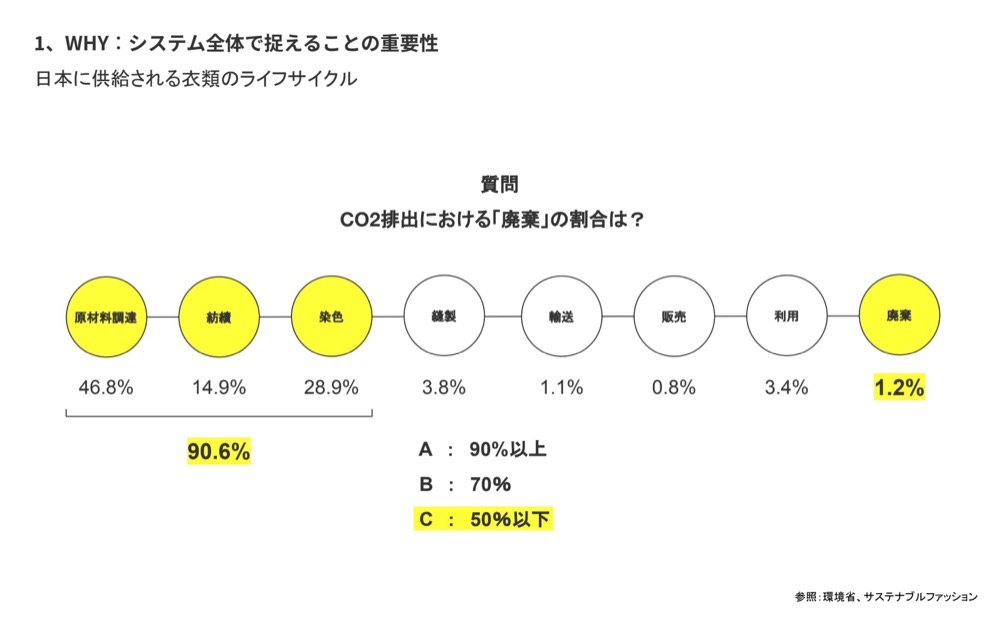
Source: Minemura’s presentation materials
Despite more than 30 years of warnings about climate change, global CO2 emissions have continued to increase, even as numerous initiatives have been implemented worldwide. Minemura pointed out that this outcome is the result of ‘whack-a-mole’ solutions that fail to tackle underlying structural problems.
He went on to emphasize the importance of what he called ‘responsibility’—the ability to respond.
Minemura: “When discussing ‘corporate social responsibility,’ we often use the term ‘responsibility.’ This word is derived from ‘response’ and ‘ability,’ meaning the capacity to respond. Without the capacity to respond to today’s complex challenges, we risk repeating past mistakes. That is why I encourage all of you to cultivate this ability.”
Confronting Chaos: Using Research to Solve Wicked Problems
Today, we face Wicked Problems—highly complex issues with no clear solutions or objective criteria for resolution. Minemura stressed the difficulty of addressing these problems and urged the audience to acknowledge this challenge. As a concrete approach, he introduced “design” and asserted that thorough research is the most critical element in the design process.
Minemura: “Design is the act of transforming the current state into something more desirable; it is a fundamental part of human behavior. The mindset in design requires embracing uncertainty and ambiguity to derive new meaning from complexity.”
As mentioned earlier, without understanding how ecosystems function, it is impossible to even formulate hypotheses. Research is about confronting chaos by constantly moving back and forth.
The visions you are shaping should not be abstract dreams like ‘circulating resources to create a bright future,’ but rather informed projections based on research—‘this is the future that is likely to emerge.’ This is what is required today.”
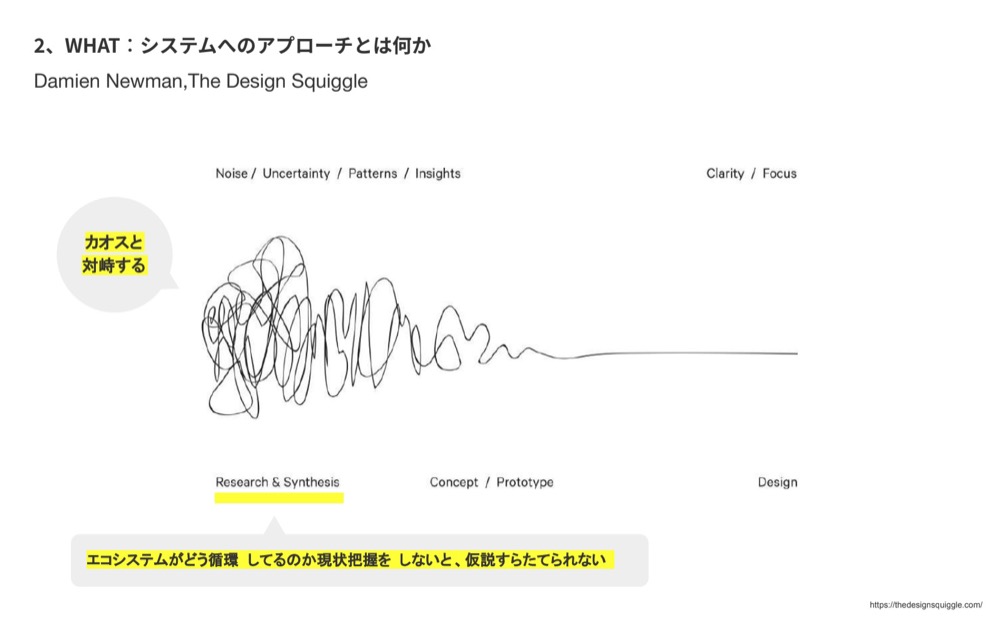
Source: Minemura’s presentation materials
To analyze the current state of systems, Minemura utilizes the Ellen MacArthur Foundation’s Butterfly Diagram. This diagram represents how resources circulate within a circular economy, in contrast to the linear take-make-dispose model. Building on this diagram, Minemura categorizes the system into four key areas: manufacturing, business models, intermediaries such as recycling companies, and overarching policies. This framework helps visualize the key players, the flow of resources, and the environmental impact associated with them.
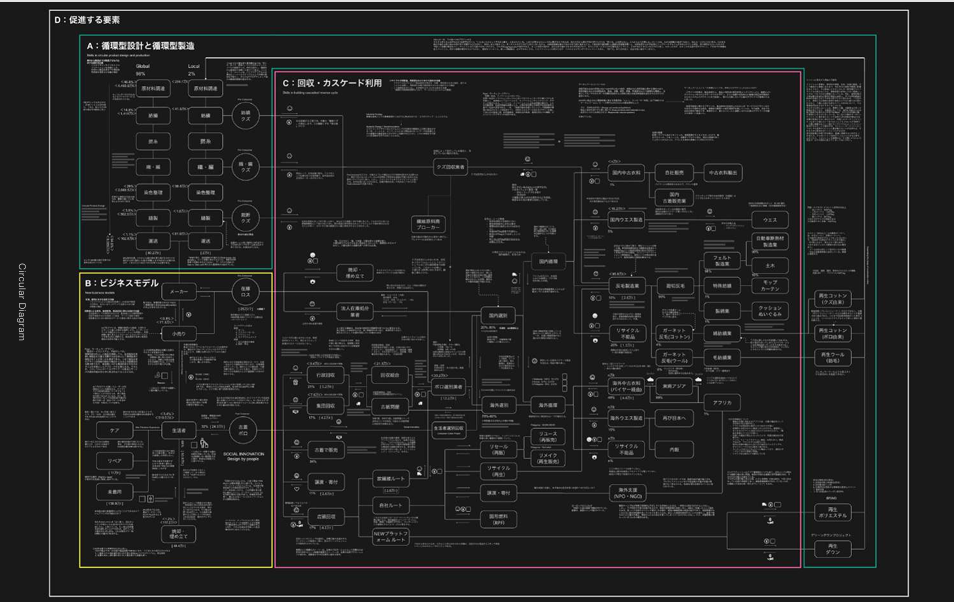
“Circular Diagram” by Shogo Minemura, based on the Ellen MacArthur Foundation’s Butterfly Diagram
Finally, Minemura offered words of encouragement, presenting a vision of the future shaped by research.
Minemura: “This is an extremely challenging process, but as you persist in researching across multiple layers and timeframes, future scenarios will gradually become clearer. We are not pursuing vague dreams; we are striving to uncover tangible and vivid future scenarios. What matters most is taking concrete steps forward, no matter how difficult the path may be.”
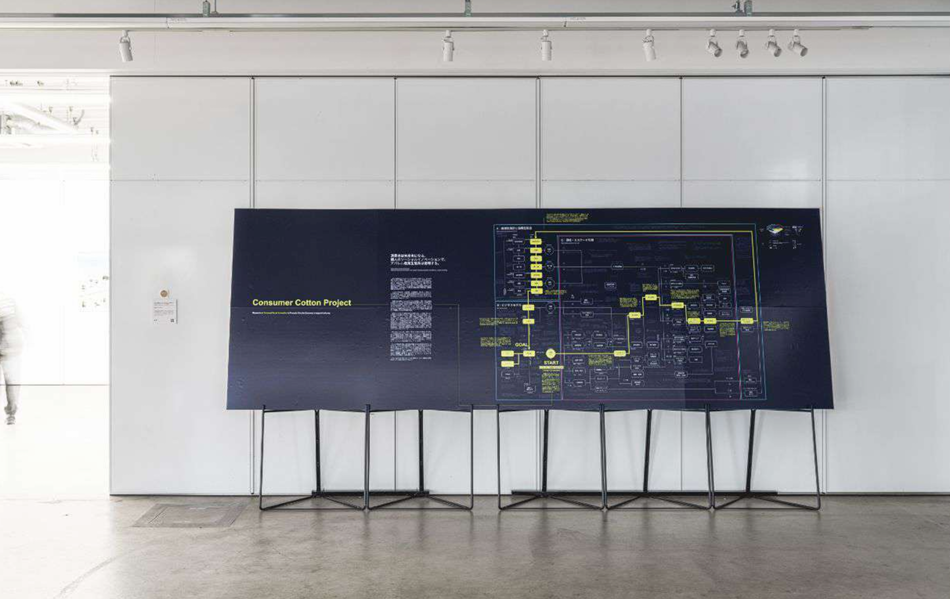
“Circular Diagram” by Shogo Minemura, based on the Ellen MacArthur Foundation’s Butterfly Diagram
Circular Economy: Transforming Value Creation and Delivery from the Ground Up
In the latter half of the session, Nasu, CEO of Circle Design Inc., delivered a lecture on the definition of the circular economy and key perspectives for developing more structured business models. He began by emphasizing that the circular economy fundamentally reshapes both how value is created and delivered.
Nasu:“For example, Philips Lighting (now Signify) has implemented a business model that sells light as a service rather than physical lighting products. This approach fundamentally changes how value is delivered compared to traditional lighting sales.
Furthermore, under this business model, the company provides maintenance and management services for lighting equipment while adding additional value through energy savings and CO2 reduction via automatic dimming. In this model, Signify retains ownership of the lighting equipment, which has led to a 47% reduction in material footprint. This illustrates how both the approach to value creation and its delivery undergo fundamental changes in a circular economy.”
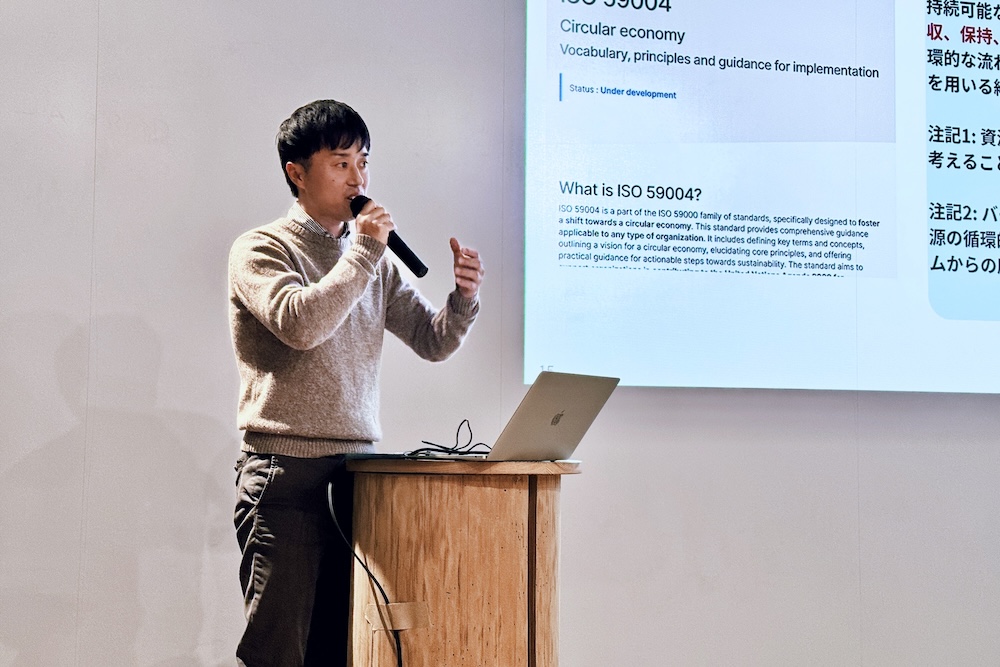
Kiyokazu Nasu, Circle Design Inc.
Nasu continued by explaining that efforts to establish a unified definition of the circular economy are gradually taking shape.
Nasu: “There are over 200 definitions of the circular economy in academia, and interpretations vary from person to person. This lack of clarity has hindered progress in transitioning to a circular economy. In response, efforts have emerged in recent years to establish a clearer and more standardized definition.”
He highlighted key insights from definitions proposed by various countries, organizations, and ISO standards.
Nasu: “Of course, resource circulation is important, but even more critical is focusing on the concept of value. This perspective will be essential as you develop your business strategies. Another crucial aspect is the systemic approach that Minemura also mentioned. To move beyond the traditional 3Rs (Reduce, Reuse, Recycle), it is necessary to take a holistic view of systems rather than focusing solely on individual components such as materials, business models, and stakeholders.”
Building on this, Nasu introduced the Ellen MacArthur Foundation’s three principles of the circular economy and emphasized the importance of mastering these frameworks.
Nasu: “As more companies adopt circular economy practices, especially overseas, we are seeing trends where investments and guidelines are aligned with the Ellen MacArthur Foundation’s three principles and their Butterfly Diagram. Building on this, Nasu introduced the Ellen MacArthur Foundation’s three principles of the circular economy and emphasized the importance of mastering these frameworks. This broader perspective allows businesses to build ecosystems that are not only sustainable but also competitive.”
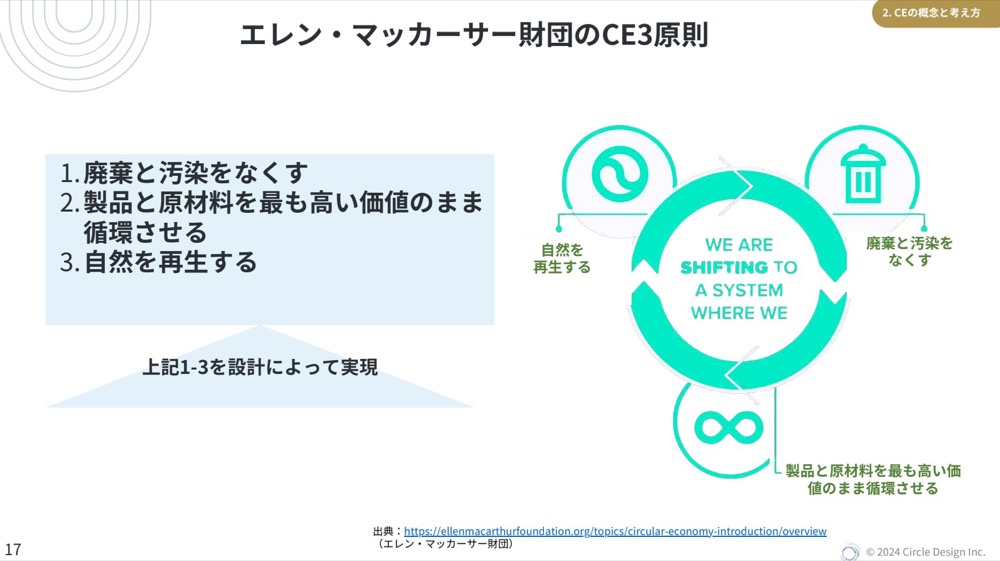
Source: Nasu’s presentation materials
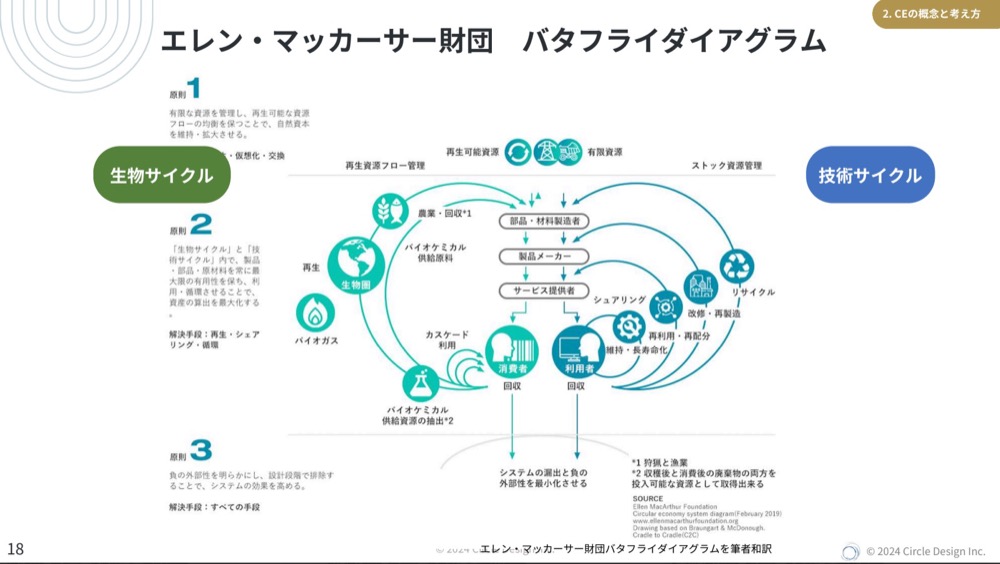
Source: Nasu’s presentation materials
Considering Business from the Perspectives of Carbon Neutrality, Nature Positivity, and the Circular Economy
Nasu emphasized the importance of taking a holistic approach to business by considering three key perspectives: carbon neutrality, nature positivity, and the circular economy. As an example, he discussed LEGO’s decision to abandon the development of recycled PET bricks due to the potential increase in CO2 emissions.
Nasu: “Had LEGO focused solely on the circular economy, they might have proceeded with development. However, from the perspective of carbon neutrality, it would have been counterproductive, leading them to halt the project. Some media framed this as a setback for sustainability, but I see it as a decision that carefully considered carbon neutrality.
It is not uncommon for efforts to advance the circular economy, such as servitization and recycling, to inadvertently result in increased CO2 emissions. Conversely, the circular economy has the potential to support carbon neutrality, given that 45% of global CO2 emissions stem from the production and consumption of goods and food. Similarly, in terms of nature positivity, the circular economy can yield both positive and negative effects.
Therefore, I believe it is crucial to integrate these perspectives from the outset and clearly articulate how your business contributes to carbon neutrality and nature positivity. This will, in turn, enhance the value of your business.”
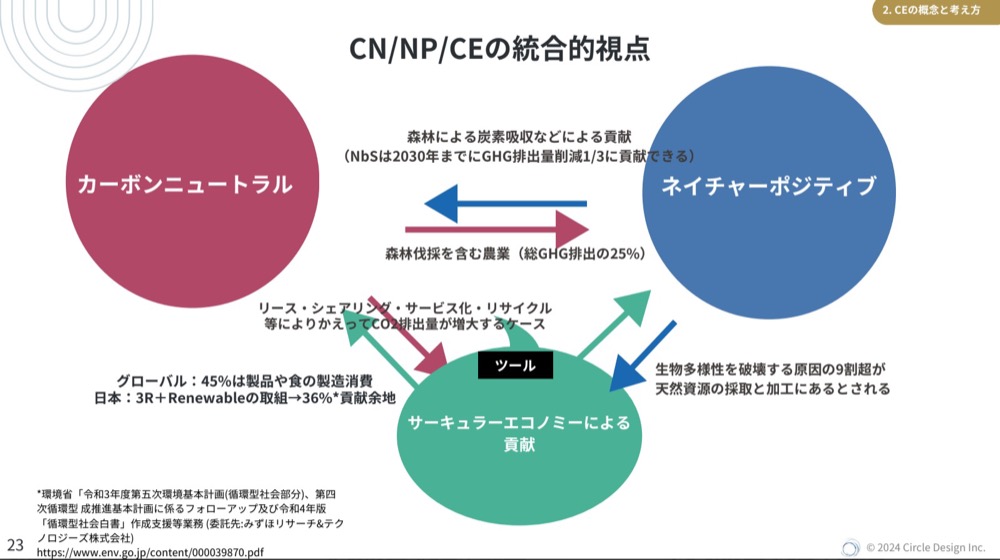
Source: Nasu’s presentation materials
Conclusion
From the insights shared by both speakers, we gained a deeper understanding of the importance of broadening our perspectives to grasp entire systems, accurately determine our businesses’ roles within them, and chart their growth trajectories.
The next session will be the second installment of the Circular Business Design Lecture. In addition to attending lectures, participants will have the opportunity to deepen their learning through mentoring from dedicated and specialist mentors, as they advance their projects in preparation for Demo Day. We eagerly anticipate how each participant will refine their ideas and bring their projects to the next level!
